Botox Injections for TMJ (Temporomandibular Joint)
Our jaw muscles are some of the most active facial muscles, working continuously throughout the day and often holding tension at night. Unfortunately, this activity can lead to misalignment, stress, and pain in the temporomandibular joint (TMJ). Symptoms include jaw pain, aches around the ear, chronic migraines, and jaw dysfunction, which can result in difficulties with chewing and opening or closing the mouth. TMJ disorders can feel as if they are hindering your overall quality of life. While pain or soreness around the jaw joint and lower jaw might not indicate serious issues for everyone, some patients may develop more serious temporomandibular joint disorders, abbreviated as TMDs, which can lead to chronic facial pain. Fortunately, Botox injections can help relieve jaw and muscle pain associated with TMJ disorders, with minimal downtime or side effects. Dr. Michele Green was one of the first dermatologists in NYC to incorporate Botox injections into her patients’ treatment plans for alleviating TMJ pain.
Botulinum toxin, commonly known as Botox, is an injectable treatment that inhibits nerve signaling and effectively “freezes” the muscles at and around the injection site. While many patients associate “Botox” with cosmetic treatments to eliminate frown lines and other facial wrinkles, it is also frequently utilized to treat medical conditions, such as chronic migraines and TMJ pain. Since TMJ disorders arise from overuse or discomfort in the masseter muscle of the jaw, Botox functions as a muscle relaxant, alleviating tension along the jawline and relieving symptoms of TMD, including headaches, lockjaw, and jaw pain. If you experience jaw pain and soreness, tension headaches, or other troubling TMJ symptoms, Botox injections from Dr. Green can provide the relief you have been seeking.
New York-based, board-certified cosmetic dermatologist Dr. Michele GreenNew York-based, board-certified cosmetic dermatologist Dr. Michele Green is an expert in numerous non-invasive cosmetic procedures, including Botox injections to treat symptoms associated with TMJ disorders. Dr. Green embraces a less-is-more philosophy and adopts a holistic approach to treatment, tailoring each patient’s plan to best address their specific concerns and overall aesthetic goals. She is consistently recognized as one of NYC’s top dermatologists by Castle Connolly, New York Magazine, and Super Doctors due to her commitment to her patients and her expertise. When you consult with Dr. Green at her private dermatology office in the Upper East Side neighborhood of Manhattan, she will collaborate with you to create a personalized Botox treatment plan that helps you look and feel your best.
What is TMJ Disorder (TMD)?
The temporomandibular joint, or TMJ, is the area where the jaw bone (mandible) connects to the skull (temporal bone), functioning essentially like a sliding hinge on either side of the face. The connecting parts of the bones have a cartilage covering and are separated by a small disk designed to absorb shock and maintain smooth jaw movements. Many patients experience jaw pain or discomfort in this joint. Chronic jaw clenching and teeth grinding can lead to an overactive masseter muscle that grows larger and more painful over time. This jaw tension particularly affects patients during sleep, as it leads to teeth grinding that can ultimately damage them.
TMD/TMJ can be triggered by bruxism (teeth grinding or clenching) or by injury to the jaw, head, or neck muscles, such as from a heavy blow or impact. Additionally, TMJ pain may arise from genetic factors or arthritis, as well as when the disk erodes or shifts from its proper alignment. Research by the National Institute of Dental and Craniofacial Research estimates that more than 10 million Americans suffer from TMJ issues, experiencing associated tension headaches, pain, tension, clicking, and grinding.
What are the symptoms associated with TMJ?
Symptoms of TMJ/TMD include:
- Jaw pain/soreness
- Jaw clicking or popping
- Facial pain behind the eyes, neck, or shoulders
- Ringing in the ears
- Headaches ranging from mild, dull aches to chronic migraines
Typically, individuals experiencing symptoms of TMJ, such as bruxism, do so cyclically. The pain may subside on its own or with minimal treatments, such as anti-inflammatories or alternating heat and cold packs along the jaw. However, recurring TMJ symptoms or prolonged symptoms often lead to significant pain that necessitates medical or dental treatment.
Note: Dr. Green only performs Botox for cosmetic indications and does not treat migraines.
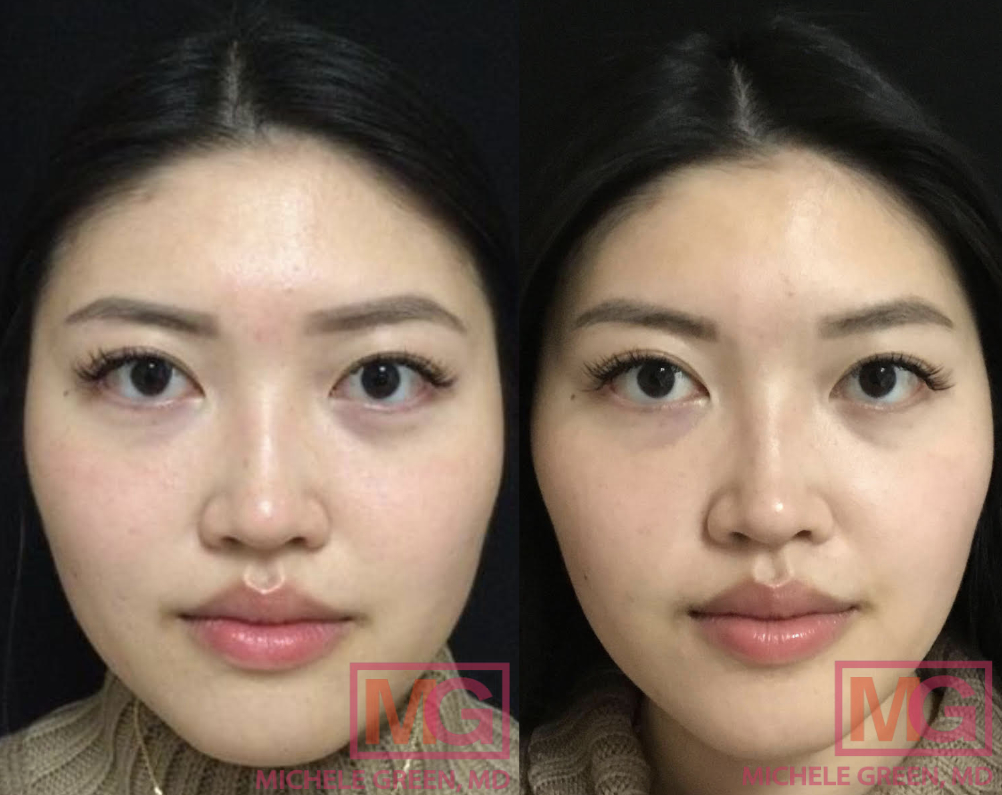
Before and after 1 treatment of Botox to the Masseter muscle area
Can Botox Relieve TMJ?
Absolutely! In the past, those suffering from TMJ pain have relied on mouthguards, bite guards, or stabilization splints to alleviate jaw tension while sleeping. For many patients, the pain is so severe that they resort to “no-chew” diets, cognitive behavioral therapy, physical therapy, or surgical intervention. Often, these TMJ treatments yield inconsistent results, prompting the exploration of alternative therapies. Fortunately, Botox injections in the jaw are non-invasive, require no downtime or side effects, and are highly effective at alleviating TMJ symptoms. TMJ disorders are often caused by overuse of the masseter muscles from excessive chewing, stress from jaw clenching, or grinding teeth at night. Botox effectively relieves TMJ-related pain by weakening the masseter muscle. When this occurs, the jaw muscle no longer contracts excessively or involuntarily, which reduces the tension in the jaw.
What is Botox?
Botox, or botulinum toxin type A, is a neurotoxin derived from the Clostridium botulinum bacterium. It inhibits specific nerve signals that control muscle contractions, limiting the movement of these muscles and temporarily “freezing” them. Botox injections are quick, painless, and require no downtime. The most common side effects include mild swelling and redness at the injection sites, which resolve on their own shortly after treatment. Botox takes two weeks to take full effect, after which results can last for three to four months. Many patients engage in regular maintenance sessions to achieve the best results.
How is Botox an effective TMJ treatment?
While widely known for its cosmetic uses because of its ability to smooth fine lines and wrinkles on the face, Botox is also an effective treatment for TMJ pain. When injected into the masseter muscle, the botulinum toxin blocks the neurotransmitters that signal the masseter muscles to contract involuntarily or excessively. This relaxation of the masseter muscle alleviates tension, provides pain relief, and prevents involuntary jaw clenching caused by stress or teeth grinding during sleep.
Botox injections for TMD remain an off-label use, meaning that Botox is not specifically approved for treating TMJ disorders. However, several studies have shown that Botox is safe and effective for managing TMJ. A 2003 study found that 90 percent of patients who had not responded to other treatments showed improvement after receiving Botox. According to a 2012 study, Botox was found to relieve jaw pain and improve the jaw’s movement capacity for up to three months following the injectable treatment. While more research is needed for Botox to gain FDA approval for TMJ treatment, studies indicate that the treatment is effective and safe when administered by an expert board-certified dermatologist, such as Dr. Green in New York City.
Where is Botox injected for TMJ?
To treat TMJ, Botox is injected directly into the masseter muscles of the jaw. TMJ disorders are often caused by strain or overuse of the masseter or jaw muscles. Jaw clenching, teeth grinding, and excessive use of the masseter muscles can lead to tension and pain throughout the jawline and around the face. Injecting Botox into the masseter muscles limits contractions of the masseter muscle, resulting in reduced jaw clenching and relief from TMJ pain and symptoms.
Who is a good candidate for Botox treatment for TMJ?
A good candidate for TMJ Botox is someone in good physical and mental health who seeks relief from TMJ pain and muscle soreness, as well as a reduction in teeth grinding and clenching. Patients should not have a history of severe allergic reactions, allergies to neurotoxins, or central nervous system disorders such as ALS. TMJ Botox is contraindicated in individuals who are pregnant or breastfeeding, as its safety has not yet been established.
What is the process like for TMJ Botox?
The process for treating TMJ with Dr. Green is straightforward. During your initial consultation, Dr. Green will examine your jaw, masseter muscles, and dental configuration to determine whether Botox is the appropriate treatment to relieve your TMJ symptoms. Your TMJ Botox treatment may be performed on the same day as your consultation, depending on the time available and your preference. Dr. Green will assess the strength of your masseter muscles and mark the injection areas. She will then inject the Botox into these marked areas. Most patients feel little to no discomfort thanks to Dr. Green’s practiced hand during the Botox injection process. The final effects of Botox can take up to two weeks to develop. Dr. Green invites her patients to return to the office for an examination to ensure complete treatment of the area. Patients with particularly strong masseter muscles may require additional Botox injections at this time. TMJ Botox lasts three to four months, after which patients can schedule another treatment session to maintain and enhance results.
Are there any side effects associated with TMJ Botox?
When a board-certified dermatologist, such as Dr. Green in NYC, performs your Botox treatment, there are few side effects. The most common side effects of Botox injections are mild swelling, redness, or muscle weakness at or near the injection sites. These side effects typically resolve on their own shortly after treatment. The procedure is painless, as Botox injections do not cause discomfort in this area. Patients do not need to apply a topical numbing cream in the treatment area to prepare for this procedure.
It is important to note that, although research on Botox treatments for TMJ has been positive, this alternative therapy has not yet received approval from the Food and Drug Administration (FDA), which means it is considered an “off-label use” for Botox injections. It is essential to consult an experienced, board-certified dermatologist, such as Dr. Michele Green in NYC, for your Botox injections for TMJ treatments to ensure safe and effective care.
What not to do after TMJ Botox?
Botox treatment is a safe and effective option for TMJ that requires no downtime after the procedure. Patients may experience minor side effects in the days following the treatment, such as swelling, bruising, redness, and soreness at the injection site. However, these side effects typically resolve on their own within a couple of days. Dr. Green recommends avoiding any rubbing or massaging of the treatment area to prevent the botulinum toxin from spreading to surrounding areas. Patients can expect to see the full results of the treatment approximately two weeks after the procedure, and the effects of Botox usually last for three to four months.
How long does TMJ Botox last?
Botox is an injectable neurotoxin that typically lasts for 3 to 4 months, depending on the individual and the severity of their jaw pain. Adhering to a regular treatment schedule for Botox injections is the most effective way to achieve ongoing symptom relief. With each subsequent treatment of Botox injections in the masseter muscle, the muscle reduces in size, TMJ relief lasts longer, and the cosmetic effects of facial slimming continue to improve. During your consultation with Dr. Green at her NYC dermatology office, she will collaborate with you to develop a treatment plan for your Botox injections that best meets your needs.
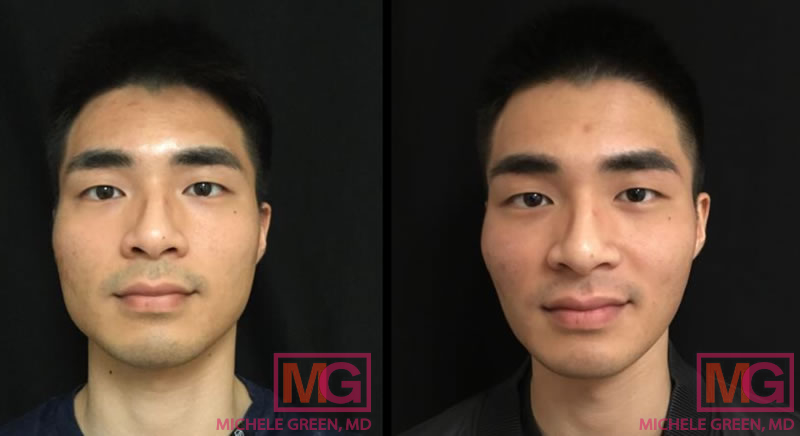
Botox to masseter area – 3 months
Frequently Asked Questions (FAQs) about TMJ Botox?
Is TMJ and masseter Botox the same?
Yes, TMJ and masseter Botox are the same treatment. Patients seeking to address TMJ symptoms, such as jaw clenching and muscle pain, often call the procedure TMJ Botox, while those aiming to slim their jawline typically refer to it as masseter Botox.
Can Botox treat TMJ?
Many patients wonder, “Can masseter Botox help with TMJ?” The answer is yes! Overactive and hypertrophic masseter muscles often lead to TMJ pain and symptoms. Botox injections inhibit nerve signaling in targeted muscles, resulting in decreased muscle contractions. When injected into the masseter muscles, Botox temporarily “freezes” these muscles, reducing teeth clenching and grinding. Over time, with regular treatment sessions, Botox can decrease the size and strength of the masseter muscles, continuously improving TMJ symptoms.
Can Botox cause TMJ?
No, Botox injections actually help relieve pain, soreness, and tension associated with TMJ. Botox treatment can also help reduce TMJ symptoms such as clenching and grinding, ultimately preventing future damage to the jaw joint. While Botox injections can cause mild and common side effects, including slight redness and swelling at or around the injection site, these typically resolve shortly after treatment. However, jaw pain is generally not reported following Botox injections. Botox is considered a very safe and effective treatment for TMJ disorders, and the risk of developing any serious side effects is significantly minimized when treatment is sought from an expert, board-certified dermatologist like Dr. Green.
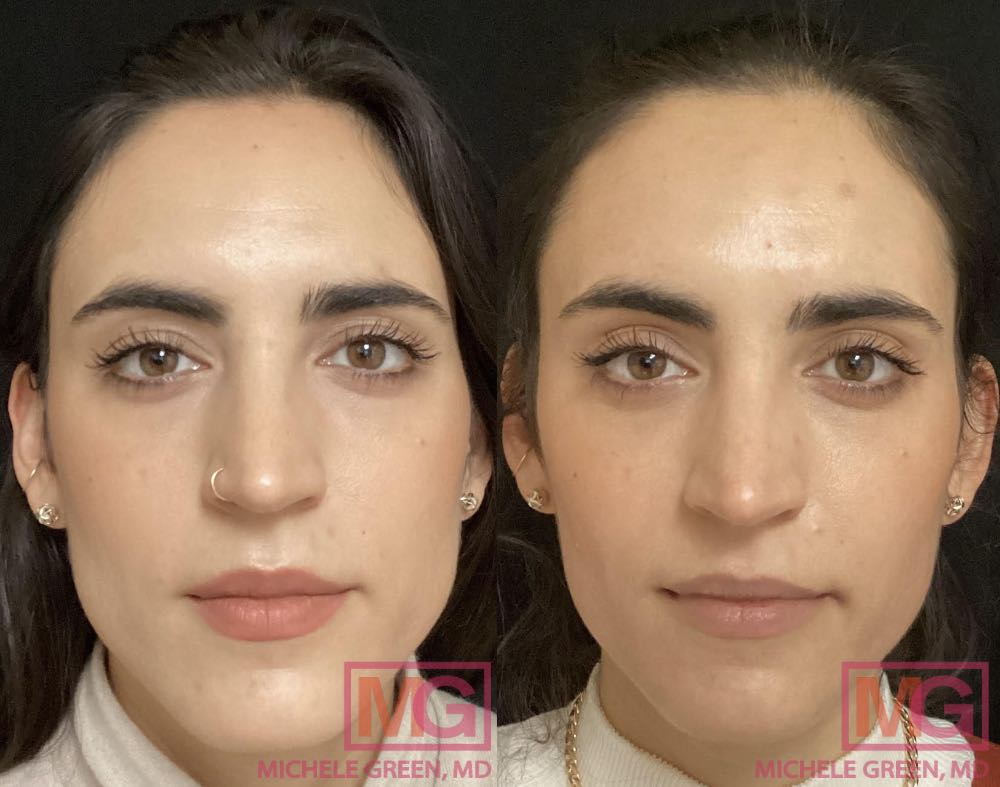
Is Botox FDA-approved for TMJ?
While botulinum toxin injections are FDA-approved for many muscular disorders, Botox for TMJ is considered an off-label treatment and is not FDA-approved. Nevertheless, healthcare providers have used Botox off-label for many years to relieve pain and symptoms associated with TMJ and TMD. TMJ Botox has proven to be extremely safe and effective, especially when administered by an expert board-certified dermatologist like Dr. Green. With over two and a half decades of experience treating patients with Botox for cosmetic purposes and TMJ pain, she was among the first dermatologists in NYC to incorporate Botox into her patients’ treatment plans. With Dr. Green, you can be assured that your TMJ Botox will be safe and effective.
Do dentists do Botox for TMJ?
When choosing a provider for your Botox injections for TMJ treatment, it is recommended to seek an experienced, board-certified dermatologist like Dr. Michele Green in New York City. A facial plastic surgeon, dentist (DDS), or nurse injector can also administer Botox injections for TMJ. However, a board-certified cosmetic dermatologist possesses extensive medical knowledge of the facial muscles involved in TMJ and carefully considers the cosmetic effects of Botox along with the patient’s aesthetic goals. During your consultation with Dr. Green at her private dermatology office on the Upper East Side, she will collaborate with you to customize your Botox treatment plan to address your needs and achieve your ideal results.
Where do they inject Botox for TMJ?
Botox injections for TMJ are most commonly administered in the masseter muscles but may also be applied in the temporalis area. The number of injections and areas of treatment depend on several factors, including the size of the masseter muscle and the specific areas of pain. During your initial consultation with Dr. Green, she will evaluate the treatment areas, and you will discuss the nature of your pain to determine the appropriate locations and quantity of injections needed to effectively treat your condition.
Does TMJ Botox hurt?
Not at all! While some patients may experience slight discomfort with the injection, it is not painful. TMJ Botox is a quick and painless procedure conducted in Dr. Green’s private dermatology office, and no numbing cream is necessary for treatment.
How much Botox do you need for TMJ?
Several factors influence the number of units required, including the size of the masseter muscle, the severity of muscle tension, and the individual shape of the patient’s face. During your initial consultation with Dr. Green, she will assess the treatment area and provide you with a more accurate estimate of the number of Botox units needed to address your specific requirements.
How much does TMJ Botox cost?
The cost of your The cost of your TMJ Botox can vary based on several factors, including the geographic location of the treatment office, the experience level of your injector, and the amount of Botox needed. Botox treatment may be priced per treatment area or by the units of Botox used. The number of units required for effective TMJ treatment differs among individuals, depending on the size and strength of their jaw muscles. After your initial consultation with Dr. Green, her office will be able to provide an estimate for the cost of your TMJ Botox. Treatment with a qualified, board-certified dermatologist like Dr. Green may come at a higher price than at a medical spa or clinic staffed by a nurse injector. However, consulting an experienced, board-certified physician for your Botox injections generally reduces the risk of side effects.
Does insurance cover Botox for TMJ?
While most insurance companies do not cover Botox injections for TMJ, it is advisable to contact your insurance provider directly to confirm coverage. They can inform you about what your plan includes and excludes, including Botox treatment options.
Does TMJ Botox affect your smile?
TMJ Botox helps relax contractions of the masseter muscle, alleviating TMJ pain and its symptoms. With regular treatment sessions, the masseter muscle continues to weaken, resulting in reduced teeth clenching and grinding. Decreased hypertrophy of the masseter muscle may also enhance the appearance of a slimmer jawline. Additionally, TMJ Botox positively impacts your smile — by relaxing the masseter muscle, it can help patients achieve a more natural, pain-free smile. However, it’s crucial to consult a board-certified dermatologist like Dr. Green for TMJ Botox, as improper treatment from an inexperienced injector can lead to an uneven or lopsided smile. Dr. Green is a medical and cosmetic dermatologist with over 25 years of experience administering Botox injections for TMJ and anti-aging issues. When performing TMJ Botox, she expertly injects Botox into the masseter muscle to relieve TMJ pain and create a relaxed, beautiful smile.
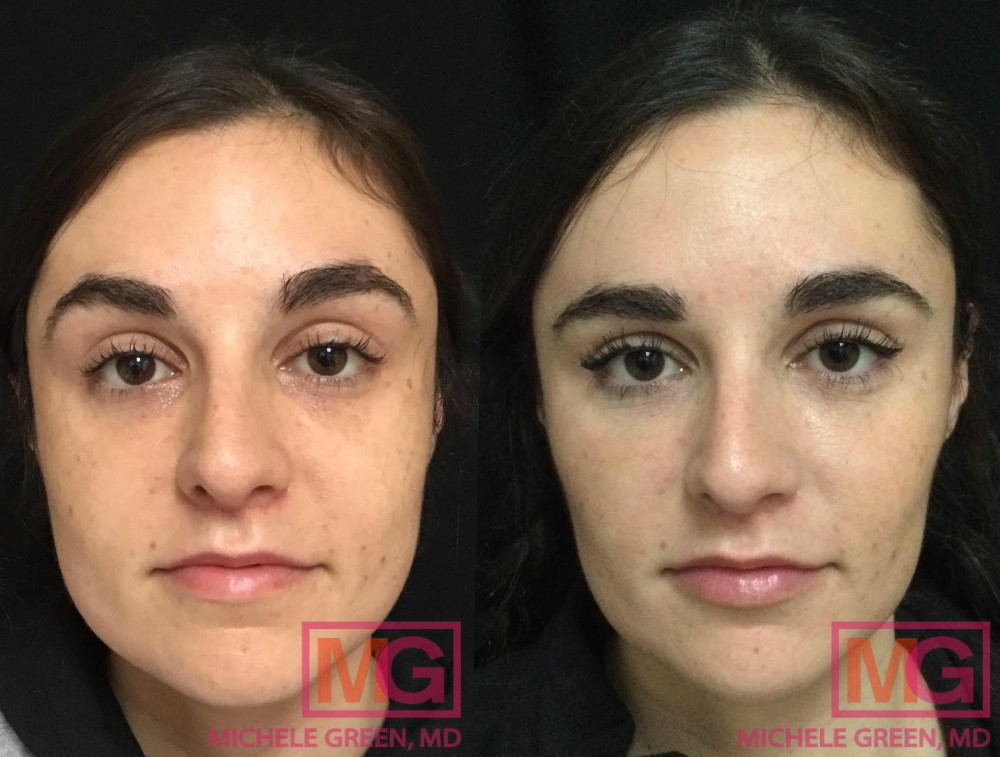
Does TMJ Botox change your face?
Yes, TMJ Botox can slim the face and create a narrower jawline. The masseter muscles in your jaw are similar to other muscles in your body in that the more they are used, such as during teeth clenching and grinding, the larger and stronger they can become. Overworked masseter muscles can cause the lower face to develop a boxy appearance, known as a square jawline. When Botox is injected into the masseter muscle, it prevents the muscle from becoming overactive, leading to a reduction in size, which decreases the squareness of the jaw and results in a slimmer face and a more V-shaped jawline. Depending on the initial size of the jaw muscles, multiple Botox treatment sessions may be required to achieve the desired facial slimming effects.
Are there alternative treatment options to TMJ Botox?
In the realm of dentistry, the accessibility of products like mouthguards and Invisalign is quite appealing and can help if TMJ pain results from teeth grinding or bruxism at night. However, while these products alleviate symptoms, they do not address the underlying cause of the pain. If TMJ disorders arise from stress and anxiety, conservative treatments such as muscle relaxants, physical therapy, acupuncture, or relaxation techniques may be beneficial in tackling the issue. Additionally, TMJ Botox is a highly effective treatment for reducing symptoms associated with TMJ and TMD. Many patients with TMJ who do not respond to more conservative treatments often experience immediate relief with TMJ Botox. When you consult with board-certified dermatologist Dr. Green, she will evaluate your masseter muscles, bite alignment, and medical history to create a customized treatment plan tailored to your specific needs.
Can you eat after TMJ Botox?
Absolutely! There is no downtime after TMJ Botox treatment, and patients can immediately resume their daily activities, including eating.
What is the downside of Botox for TMJ?
There are no downsides to Botox injections for TMJ! The advantage of TMJ Botox is that the injections are quick and painless, offering relief with no downtime or adverse side effects. Botox injections are an excellent solution for treating TMJ, as they help relax the masseter muscle responsible for teeth clenching and grinding. The Botox essentially “freezes” the jaw muscle, preventing it from contracting involuntarily or excessively. It takes two weeks for Botox to reach its full effect, after which results last for three to four months. Dr. Green recommends that patients participate in regular maintenance to achieve optimal results. With each Botox treatment session, the masseter muscle will weaken, leading to reduced TMJ symptoms and muscle pain.
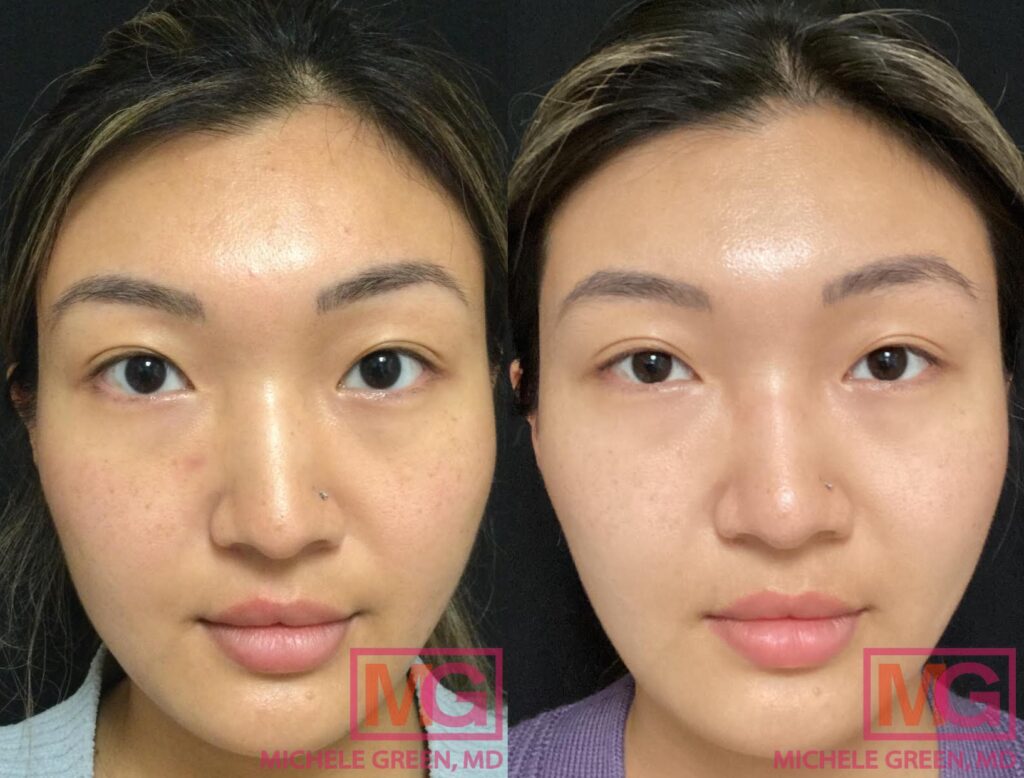
How to begin relief for TMJ pain with Botox today
Jaw tension and pain associated with TMJ disorders can significantly impact one’s overall quality of life. Even with conservative treatments like acupuncture and night guards, patients may still experience TMJ pain and symptoms. Fortunately, Botox treatment for TMJ can alleviate pain, tension, and soreness in the jaw muscles while minimizing teeth grinding and clenching. Furthermore, by reducing the strength and size of the masseter muscles, TMJ Botox treatment can create a facial slimming effect and produce a more V-shaped jawline that many find appealing. TMJ Botox is safe, effective, and long-lasting, particularly when administered by an expert dermatologist like Dr. Green. If you are tired of experiencing pain and tension in your jaw and are seeking a non-invasive treatment option for TMJ, Dr. Green is ready to assist you.
Dr. Michele Green is an internationally renowned board-certified dermatologist with over two and a half decades of experience providing some of the world’s most discerning individuals with the finest non-invasive treatment options, including Botox injections for TMJ. Dr. Green was among the first dermatologists in NYC to offer Botox injections to her patients. She has expertly performed what has been described as the “best Botox treatments” in New York at her private dermatology office on the Upper East Side of Manhattan for decades. She is consistently recognized as one of the best physicians in New York City by Castle Connolly, The New York Times, Super Doctors, and New York Magazine for her dedication to her patients and expertise. Embracing a less-is-more philosophy and taking a holistic approach to rejuvenation, Dr. Green customizes each patient’s treatment plan to address their specific concerns and achieve their personal aesthetic goals. Contact us online or call the NYC office at 212-535-3088 to begin your TMJ Botox treatment with Dr. Green and schedule an appointment today.
 212-535-3088
212-535-3088